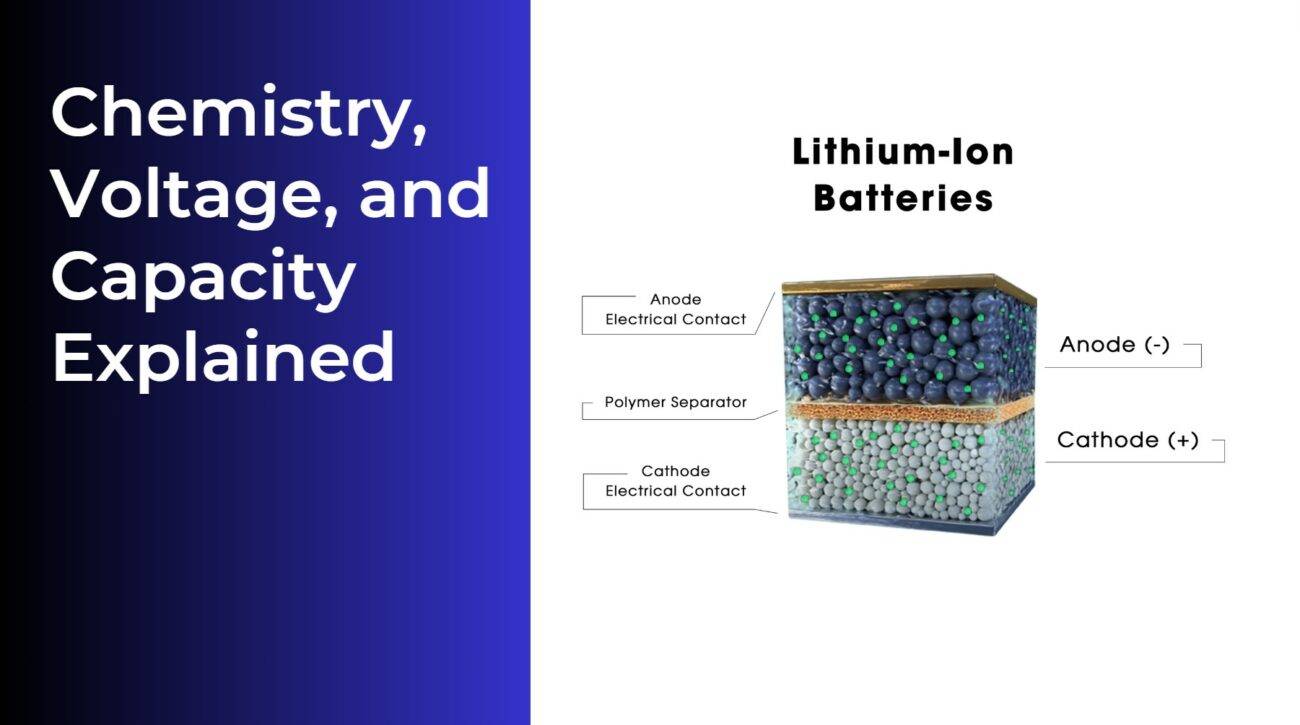- Forklift Lithium Battery
- Golf Cart Lithium Battery
- Rack-mounted Lithium Battery
51.2V 100Ah Rackmount LiFePO4 Battery
8000 times (80% DOD 0.5C)
Optional SNMP for TELECOM - Car Starter Battery
- 12V LiFePO4 Battery
12V 150Ah Lithium RV Battery
Bluetooth App | Self-heating
LiFePO4 | Group 31
UL 1642 | IEC 62619 - 24V LiFePO4 Battery
- 36V LiFePO4 Battery
- 48V LiFePO4 Battery
- 60V LiFePO4 Battery
60V 100Ah Lithium Battery (AGV, AMR, LGV)
Peak Discharge Current 400A
500 x 298 x 349 mm - 72V~96V LiFePO4 Battery
72V 100Ah Lithium Golf Cart Battery
Peak Discharge Current 315A (10S)
740 × 320 × 246 mm - Wall-mounted Lithium Battery
51.2V 100Ah 5kWh
Wall-mounted Battery532 x 425 x 170 mm / LiFePO4
>8000 Cycles (80% DOD 0.5C)
RS485 / CAN-bus
for Solar Home ESS - Home-ESS All-in-One
51.2V 32kWh
All-in-On HESS SystemPowerAll
51.2V / LiFePO4
>8000 Cycles (80% DOD 0.5C)
RS485 / CAN-bus / WiFi
All-in-One for Home ESS
How to Understand Battery Capacity: Ah and Voltage Explained

Battery capacity, expressed in ampere-hours (Ah), and voltage are key factors in determining a battery’s energy storage and performance. Understanding these terms allows you to match batteries to device requirements and optimize efficiency. HeatedBattery emphasizes that proper knowledge of Ah and voltage ensures safer, longer-lasting, and more reliable battery usage.
What Does Ampere-Hour (Ah) Mean?
Ampere-hour (Ah) measures the amount of electric charge a battery can deliver over time. For example, a 10Ah battery can supply 1 ampere for 10 hours or 2 amperes for 5 hours. Ah helps predict how long a device will run before recharging, making it essential for energy planning and selection.
How Is Voltage Defined in Batteries?
Voltage indicates the electrical potential difference between a battery’s terminals. Higher voltage batteries deliver more power per unit of current. For instance, a 12V battery produces more energy per ampere than a 6V battery. Voltage affects compatibility with devices and determines total energy output in combination with Ah.
How Do Ah and Voltage Work Together?
Battery energy in watt-hours (Wh) is calculated by multiplying Ah by voltage: Wh = Ah × V. This relationship helps compare batteries of different voltages and capacities. HeatedBattery recommends using this formula to estimate runtime and ensure devices receive adequate power.
Which Factors Affect Battery Capacity?
Temperature, discharge rate, battery age, and chemical type influence actual Ah. High discharge rates reduce effective capacity, while cold temperatures can temporarily lower output. Regular monitoring and proper usage maximize performance and maintain predicted capacity.
Why Is Knowing Battery Capacity Important?
Understanding capacity prevents overloading and ensures devices operate reliably. Correct Ah selection avoids frequent recharging and extends battery life. For renewable energy systems or electric vehicles, precise capacity matching ensures consistent energy availability.
How to Read Battery Labels for Ah and Voltage
Most batteries list Ah and voltage on their casing or datasheet. Example: “12V 100Ah” means 12 volts output with 100 ampere-hours capacity. Labels may also indicate discharge rates or recommended temperature ranges. Always verify these numbers to match device requirements.
Are All Batteries Rated the Same Way?
No, manufacturers may use different testing standards. Lead-acid, LiFePO4, and NiMH batteries report Ah differently, based on discharge rate and temperature. HeatedBattery advises reviewing datasheets carefully to understand the real-world capacity of each battery type.
How Do Discharge Rates Impact Runtime?
Faster discharge reduces usable Ah due to chemical limitations, called the Peukert effect in lead-acid batteries. Slower discharge maximizes capacity. Calculating expected current draw helps predict real runtime and avoid unexpected battery depletion.
Battery Energy Comparison Table
| Battery Type | Voltage (V) | Capacity (Ah) | Energy (Wh) | Best Use Case |
|---|---|---|---|---|
| Lead-Acid | 12 | 100 | 1200 | Backup, RV, Solar |
| LiFePO4 | 12.8 | 100 | 1280 | EV, Off-grid, High-drain |
| NiMH Rechargeable | 12 | 80 | 960 | Electronics, Portable |
How Can You Maximize Battery Life Using Ah and Voltage Knowledge?
Proper charging, avoiding over-discharge, and matching battery specifications to devices extend lifespan. Using batteries within recommended voltage and capacity ranges prevents damage, ensures safety, and optimizes energy efficiency. HeatedBattery encourages routine monitoring and adhering to manufacturer guidelines.
HeatedBattery Expert Views
“Understanding Ah and voltage is crucial for efficient battery usage. HeatedBattery emphasizes that correct matching of capacity and voltage to device requirements maximizes performance and longevity. For high-demand applications, LiFePO4 batteries often provide superior energy density and longer lifespan, while lead-acid remains cost-effective for standby or moderate power usage.”
Conclusion
Battery capacity and voltage are foundational for selecting the right energy source. Ampere-hours define how long a battery can deliver power, while voltage determines energy potential. By combining these insights with proper usage, storage, and monitoring, users can maximize performance, safety, and longevity. HeatedBattery provides reliable guidance for choosing and maintaining batteries efficiently.
FAQs
What does a 100Ah battery mean?
It can deliver 100 amps for one hour, or proportionally less current over longer periods.
How do I calculate battery energy?
Multiply Ah by voltage: Energy (Wh) = Ah × V.
Can battery capacity decrease over time?
Yes, aging and repeated charge cycles reduce effective Ah.
Which is better for high-drain devices?
LiFePO4 batteries maintain higher capacity under rapid discharge.
Does temperature affect Ah?
Yes, cold reduces chemical activity and lowers usable capacity.





















